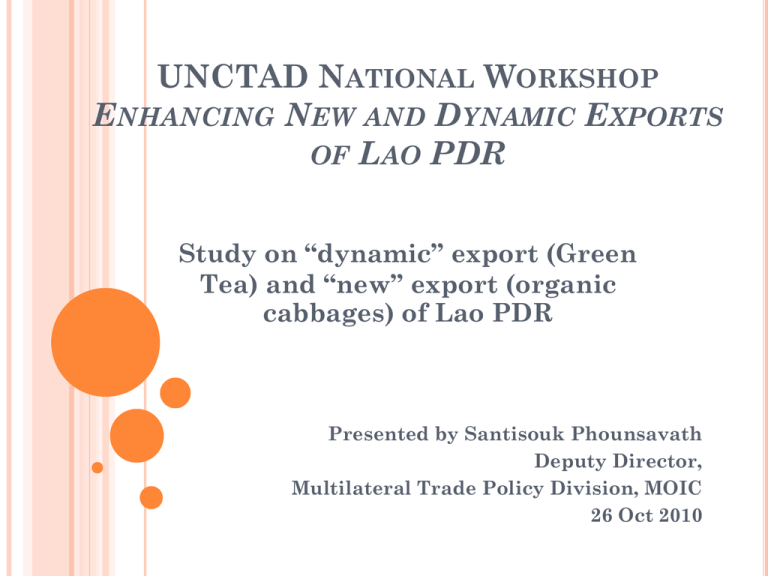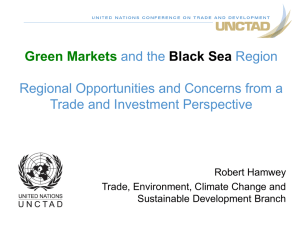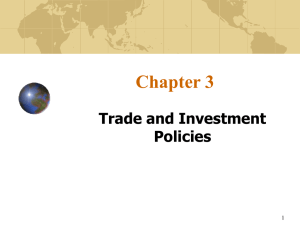Document
advertisement

UNCTAD NATIONAL WORKSHOP ENHANCING NEW AND DYNAMIC EXPORTS OF LAO PDR Study on “dynamic” export (Green Tea) and “new” export (organic cabbages) of Lao PDR Presented by Santisouk Phounsavath Deputy Director, Multilateral Trade Policy Division, MOIC 26 Oct 2010 CONTENTS Introduction/overview Dynamic exports: Green Tea New exports: Organic Cabbages Conclusion INTRODUCTION What is Dynamic exports? What is New exports? INTRODUCTION Objective of the study: “To examine selected products aiming to provide policy recommendations to unleash bottlenecks that inhibit their export potentials” OVERVIEW Status quo of agricultural Trade 2008 total export of US$ 1.4 million (26% of GDP) Avg Export Growth of 12% from 2000 to 2008 Key markets for Ag Exports: ASEAN: Thailand, Vietnam Transition Economy: China Advanced Economy: EU, Japan and South Korea OVERVIEW Why Green Tea and Organic Cabbages? Development implications: Poverty reduction, Opium eradication Minority development eg. Arkha ethnic Environmentally industries Rapid growth in demand: Green tea (World growth rate 17% pa, China: 56% pa) Cabbages export growth rate to Thailand 55% pa Methodology of the study Review of secondary data Interview relevant stakeholders Consultation Workshop DYNAMIC EXPORTS: GREEN TEA Production areas: Boliven Plateau of Champasack Province Phongsaly, Udomxay, Luang Prabang, Xieng Khoung, Huaphan (Wild tea) Processing Northern Provinces: Wild tea. i.e. Phongsaly Southern Provinces: Plant tea DYNAMIC EXPORTS: GREEN TEA Transportation: Truck Export certifications: Phytosanitary, CO. Challenges linked to green tea production: Technology Techniques Laboratory Export certification: Organic, Standard (ISO) DYNAMIC EXPORTS: GREEN TEA Investment Stats in 2010 Local investment: worth 1.8 billion Kip FDI: worth 768 million kip (China, Malaysia) Cover 2000 hectares for green tea cultivation Main challenge linked to investment: Access to finance DYNAMIC EXPORTS: GREEN TEA Exports Stats: Green tea to China: worth $US 110, 000 (2009) EU and Japan around 28-30 tons annually from 2006-08 Potential Markets: ASEAN (esp Thailand) and US Challenges linked to green tea exports Marketing Certifications: sustainably produced, standard, and organic DYNAMIC EXPORTS: TEA Recommendations: Continue trials and trainings on management and propagation techniques Make contact with researchers on Chinese side Research on ODOP approach and market opportunities Product quality/technical standards and certification Public-Private Partnership NEW EXPORTS: CABBAGES Production areas: Nationwide: 84.000 Hectares Champasak province (Pakxong District and Boliven Plateaux) 24tons/hectares, total production of 53,328 tons and; Vientiane Capital (self sufficient) Processing: Organic Plantation Cultivation truck market Export certifications: Quality, Phytosanitary, CO NEW EXPORTS: CABBAGES Challenges linked to cabbage production Lack of technical knowhow on organic farming Lack of storage facilities Lack of packaging techniques Lack of transportation facilities Lack of organized sales chains for fresh vegetables Little value addition NEW EXPORTS: CABBAGES Investment FDI $US 100 million in Champasak from 2000-08 Success of PPP example: MoUs between Lao-Thai Provincial Governors (between Champasak, Sekong, Saravanh and Ubon Rachathani) Support producers and importers to: reduce transaction costs Access to finance stimulate investment, production and trade NEW EXPORTS: CABBAGES Contract farming with Thai businesses (Ubon Ratchathani) Pros •Garantee Minimum price •Know how •Production techniques •Equipments •Seeds •Fertilizers •Cost reduction •Increase efficiency •Quality consistency •Facilitate Standard requirement Cons •Not fully understood the obligations •Monopoly rights •Push down prices •Not responsible for losses •Natural disasters i.e. flood, drought NEW EXPORTS: CABBAGES Sole export market: Thailand NEW EXPORTS: CABBAGES Challenges linked to export of organic cabbage Insufficient market information Complex export procedures Difficulties in meeting SPS/TBT and other quality standards Lack of organic certification for export Implementation of Contract Farming Market access NEW EXPORTS: CABBAGES Recommendations Establishment of information centres improve transportation infrastructure Credit available to producers for value added activities More research on vegetable value chains, off-season production high quality seeds, organic fertilizer and pesticides Advice on diversification of markets: i.e. China, Vietnam Cambodia , Middle East and Japan Promote organic cabbages NEW EXPORTS: CABBAGES Recommendations (Cons) Model contract farming to reduce transaction cost Quality standards/Organic Cerification Promote micro finance to target producers CONCLUSIONS Lack of finance is a major constraint Infrastructural constraint is the most serious bottleneck to investment Regulations are still complicated and too much paper works Cost of doing business remain high Absence of skilled manpower Needed for diversification of investment into new range of activities and higher level of growth THANK YOU FOR YOUR ATTENTION! Further information: Mr. Santisouk Phounsavath, Multilateral Trade Policy Division Foreign Trade Policy Department, MOIC Tel: 450065 Fax: 450066 Email: santisoukben@gmail.com










